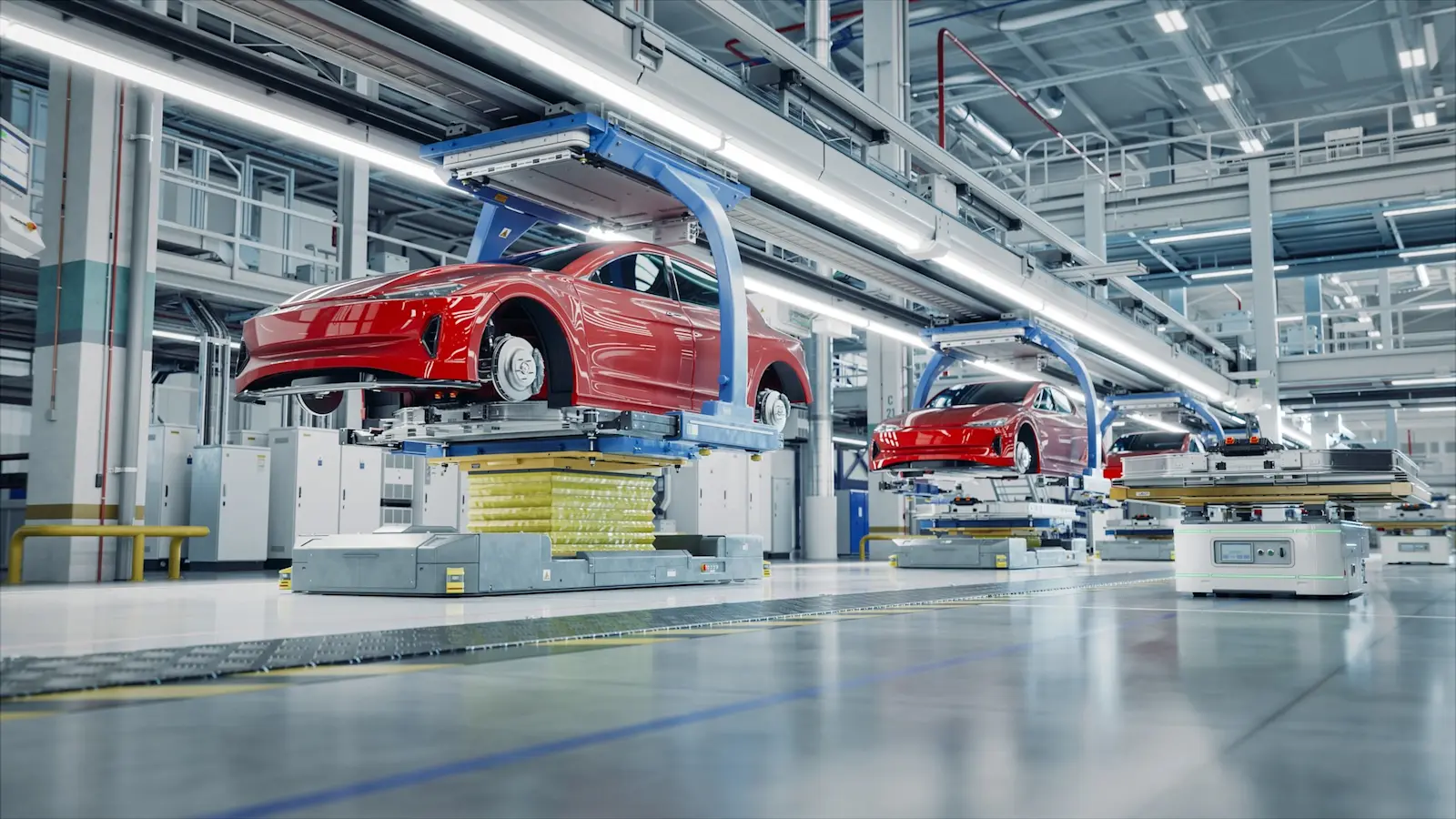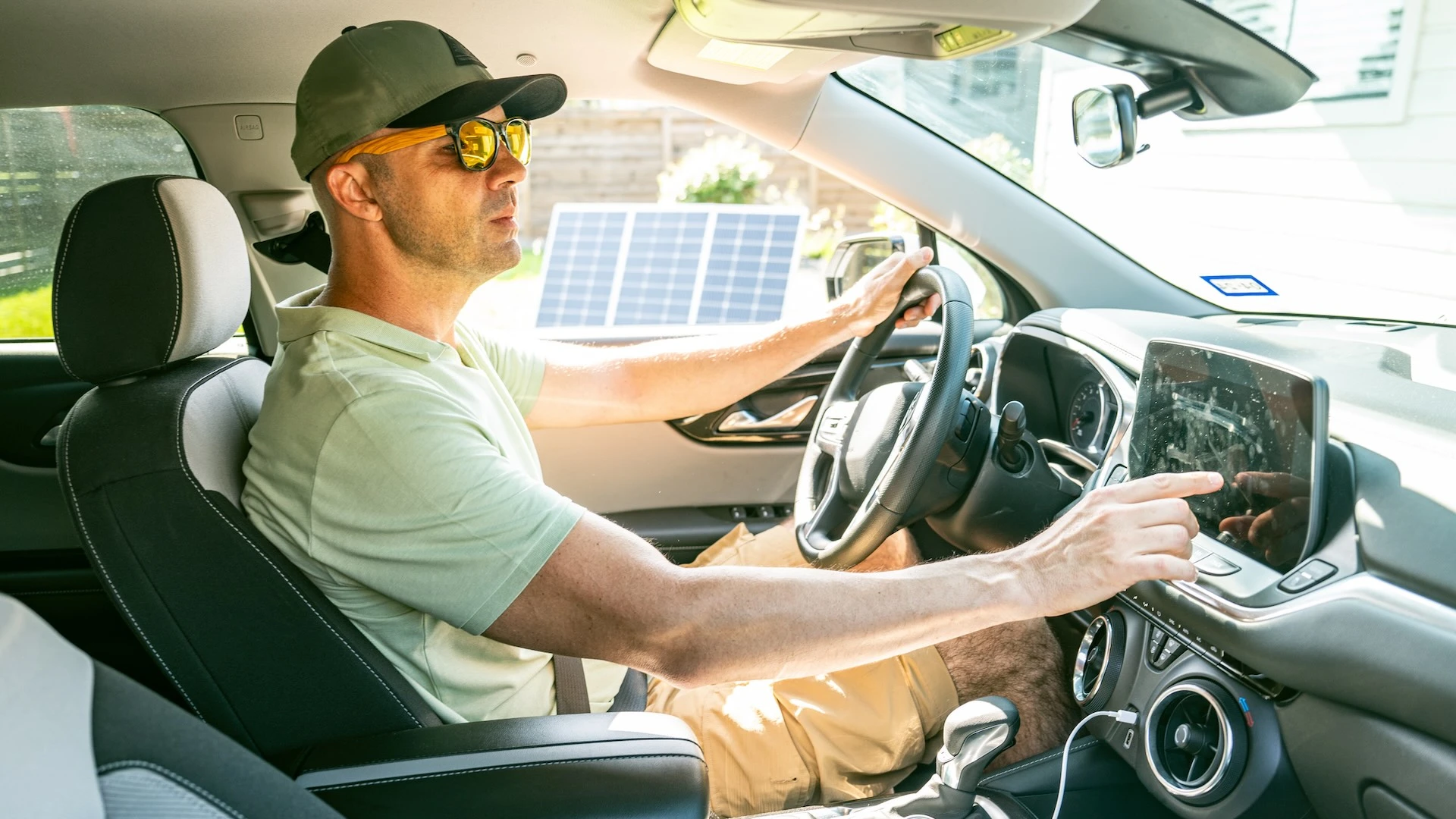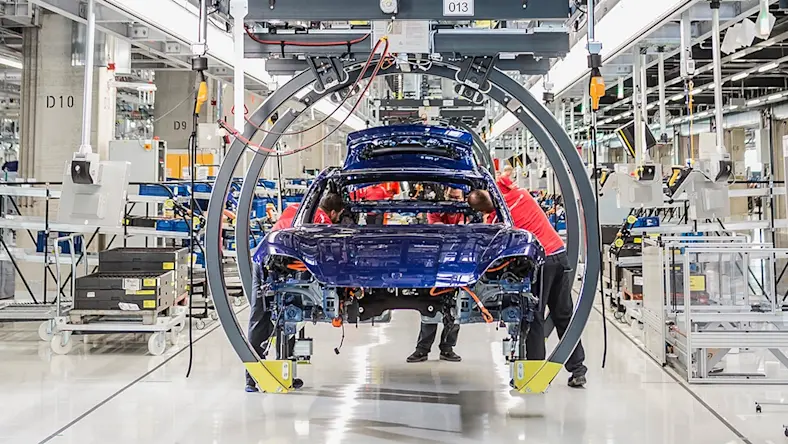& Construction

Integrated BIM tools, including Revit, AutoCAD, and Civil 3D
& Manufacturing

Professional CAD/CAM tools built on Inventor and AutoCAD
A modern passenger vehicle is a marvel of design and engineering and an epicenter for technological convergence. It is an example of superior mechanical handling that is also a computer, an Internet of Things (IoT) device, comfortable furniture, and a climate-controlled environment—one that has to keep human beings safe while moving fast through traffic.
To make such a singular product, the automotive industry deploys the latest in artificial intelligence (AI), virtual reality (VR), and other technologies that make vehicle design and production faster, more creative and configurable, more sustainable, efficient, and more software- and data-based. The industry does all this while facing many pressures, as well as opportunities, from multiple angles.
As futurist Maks Giodano noted at the Automotive Innovation Forum 2024 in Darmstadt, Germany, exponential technological growth is making the future harder to predict: “It’s totally okay to say ‘no’ to a trend,” he said. The following automotive industry trends may not dictate how the future will look, but if automotive firms choose to deny them, they should choose wisely. While not the only way to the future, these trends provide a compass for moving forward.
Continuing an ongoing trend, vehicle electrification is still on the rise. More automakers are investing in developing electric vehicles (EVs) to meet the growing demand for environmentally friendly mobility solutions and to comply with government mandates in certain countries and states.
In 2023, the growth in demand for electric vehicles slowed due to high interest rates and higher EV prices, which spiked in part because of inventory shortages brought on by supply chain issues, such as shortages in computer chips. However, in 2024, that demand trend has begun to reverse. Kelley Blue Book estimates that in the first half of 2024, nearly 600,000 EVs were sold in the United States, up 7.3% from the first half of 2023.
The gains were even higher worldwide, where research consultancy Rho Motion reports that the 7 million EVs sold globally in the first half of 2024 (including both full-battery electric vehicles [BEVs] and plug-in hybrid electric vehicles [PHEVS]) represented a 20% increase over the first half of 2023. This figure includes 4.1 million EVs sold in the first half of 2024 in China—a 30% year-over-year increase.
EV sales are likely to continue to climb, both to meet customers’ growing demand for environmentally friendly mobility solutions and due to the mandates from more than 50 countries and a few US states to phase out sales of internal combustion engine (ICE) passenger cars by 2030–2050. In addition, more than 140 countries have also passed into law targets for net-zero emissions by 2050. To achieve global net-zero emissions by 2050, the International Energy Agency (IEA) estimates that a large number of energy sector conditions would have to change, including EVs reaching 50% of all passenger car sales by 2030. BloombergNEF’s Electric Vehicle Outlook 2024 report predicts getting close to that mark, with EVs reaching 45% of global passenger vehicle sales by 2030.
Drivers will be more likely to adopt EVs as battery efficiency and EV charging infrastructure continue to improve. EV battery prices are falling, with battery manufacturers CATL and BYD both on pace to decrease prices by as much as 50% by the end of 2024, making cost parity between EVs and ICE cars more possible. Low-cost batteries make increased EV range more cost effective. As a result, EV ranges have continued to extend, reducing drivers’ EV range anxiety. Many original equipment manufacturers (OEMs) have EV models on the affordable end of their product lines with ranges of 200–250 miles or more, including Chevrolet, Hyundai, Jaguar, Kia, Nissan, Tesla, and others.
The critical nature of software within modern vehicles has given rise to another vehicular acronym for the automotive lexicon: the software-defined vehicle (SDV)—or more casually known as a “computer on wheels.” The term SDV describes vehicles in which software determines many aspects of the vehicle’s performance, operations, and features, such as driver-assistance features, safety features, infotainment, and more.
An SDV can modify and improve that functionality with over-the-air software updates—like a smartphone updating its operating system (OS). With an SDV, automakers decouple vehicle hardware and software functions while making sure that the hardware and software collaborate and align with each other.
There are several technological layers to SDVs, including the major software systems handling the in-vehicle infotainment (IVI) and the advanced driver-assistance system (ADAS), which handles aspects of autonomous driving. Different automakers take varied approaches to developing these software systems and the hardware for running them, such as the vertical approach that Tesla takes to develop much of this technology in-house. Many other OEMs take a horizontal approach, where they partner with different providers for key SDV elements like a cloud platform (Google Cloud, AWS, Azure); the end-user app system (Android, Amazon, ThunderSoft); the car OS (Android Auto, Apple CarPlay, Car Penguin); the user interface (often developed in-house); and the system-on-a-chip (SoC) computing hardware (Intel, Nvidia, Qualcomm), which powers the advanced artificial intelligence (AI) needed for the Level 2 and Level 3 autonomy of certain ADAS features.
Analysts have predicted that the overall market for SDV software and electronics will surpass $1 trillion by 2035. Given the difficulty any single OEM would face perfecting each layer of the SDV system, they also predict that automakers will, out of necessity, open up to greater collaboration or “co-opetition” to establish partnerships that can monetize the areas where each company excels.
For example, two strong OEMs in ADAS technology are BMW and Mercedes-Benz, the latter of which was the first automaker approved in the United States to launch production models with Level 3 ADAS in late 2023. The Mercedes-Benz Level 3 Drive Pilot includes conditionally automated driving that, when activated, will unlock certain apps on the infotainment display. Mercedes-Benz and other automakers with sufficiently advanced SDV technology will have the opportunity to profit from licensing part or all of its technology should the spirit of co-opetition take hold.
Automakers can also monetize new services and sales from SDVs. As connected cars, they can become part of the drivers’ smart home and a conduit to payment services such as streaming content, smart home subscriptions, roadside assistance services, and so on.
In vehicle production, software has been important to design and engineering for many years. Advancements in interoperable data and the centralization of design and engineering data on cloud-connected platform software help to remove barriers between these departments caused by incompatible files or data. For example, design houses and automotive companies using Autodesk Alias and VRED software—which feature complete data interoperability—can easily share information seamlessly between departments to save time when working on design iterations.
Self-driving cars and trucks have bubbled on the surface of real-world viability for at least a decade, but now they are beginning to break through the barrier of controlled testing into real-world autonomous driving scenarios. New technological developments are popping up, such as May Mobility making a large data set available to autonomous vehicle researchers that includes rare, real-world data from multiple vehicles driving repeated trips. And partnering with Stanford University, Toyota for the first time made two autonomous test vehicles drift around a track simultaneously without colliding.
Major automakers such as Ford, GM, Tesla, Volkswagen, and Volvo are all testing the autonomous vehicle waters. There were also 1,400 self-driving cars being tested in the United States from more than 80 companies. These include autonomous rideshare pilot programs from Alphabet, Inc., subsidiary Waymo taking place in San Francisco, Phoenix, and Los Angeles. Driverless cabs from Pony.ai and Baidu are also operating in China.
Driverless taxis require Level 4 autonomy on the SAE’s Level 0-5 scale of driving automation. (Mercedes-Benz’s Level 3 autonomy mentioned above amounts to a “traffic jam chauffeur,” limited to autonomy in specific driving conditions.) A McKinsey survey estimates that Level 4 robo-taxis will be viable at scale by 2030 and that fully autonomous Level 5 trucking could be ready between 2028 and 2031.
The same McKinsey survey revealed that 96% of mobility executives believe that industry partnerships are vital to spurn innovation, de-risk investments, and build the infrastructure needed to scale up autonomous vehicles. Some innovation is required around the evolving interplay among the main sensors of autonomous vehicles: cameras, radar, and LiDAR. These sensors generate massive amounts of data that must be processed by AI powered by advanced SoCs dedicated to in-vehicle computing—like the NVIDIA DRIVE Thor expected in 2025.
To convince customers and stakeholders of this new driverless-car mobility model, automotive manufacturers like Italian design company Italdesign are using VR and simulation software such as VRED to show people how riding in an autonomous vehicle will look and feel.
According to Deloitte’s 2024 Global Automotive Consumer Study, economic uncertainty has made young people age 18–34 around the world more interested in forgoing car ownership in favor of a vehicle subscription model. This includes 67% of respondents in India, 48% in China, and 28% in the United States. Those who expressed interest also said they want a predictable cost structure, reliable vehicle availability, and convenience from a subscription plan.
Among customers of all ages, online vehicle sales and research are picking up. Automotive research firm IMARC reports that online car sales in the United States hit $326 billion in 2023 and predicts that they will reach $754.2 billion by 2032. That’s a compound annual growth rate (CAGR) of 9.6% from 2024 to 2032. In Cox Automotive’s 2022 Car Buyer Journey Study, 80% of respondents said they were open to buying a car entirely online, up from 76% in 2020.
There are many ways in which the automotive industry is working toward helping rather than hindering sustainability goals.
For instance, a significant push toward choosing more sustainable materials in vehicle production includes an increasing emphasis on improving fuel efficiency by designing lighter-weight parts, either by optimizing weight with generative design or using lighter-weight composites and other materials. Focusing on the longevity of parts such as tires and interiors and using durable coatings to reduce rust and other wear can also extend vehicle lifespan.
Automakers are also stepping up their use of sustainable, recycled, and upcycled materials, which the 2024 Kia EV9 exemplifies well. This electric SUV replaces petroleum products with sugarcane bioplastics and corn and castor oil biopolyurethane, as well as using recycled plastic from fishing nets for flooring and recycled polyethylene from plastic bottles for seat stitching and the luggage board. Volkswagen has committed to making its car parts more recyclable, using more sustainable materials, and using recycled materials for textiles.
Other materials trends include using plant-based leather, recycled steel, reclaimed wood, and antimicrobial materials that reduce the need to use potentially polluting cleansers.
As EVs continue to proliferate, the industry and government are making efforts to improve charging-station access and EV battery recycling. A more comprehensive EV battery solution is needed, but advancements are allowing EV battery graphite and electrolyte recycling, as well as reusable electrodes. Courtesy of the US government, EV charging infrastructure will get a boost of around a half-million public chargers—spaced no more than 50 miles apart on major highways—by 2030. Private companies such as Hertz, EVgo, GM, and BP are also stepping up fast-charging networks by adding thousands of charging ports while Tesla has promised to make at least 7,500 of its charger destinations available to all EVs by the end of 2024.
As the World Economic Forum reports, governments in China, Europe, India, Japan, the United States, and others have set policies for aligning the mobility industry with sustainable development goals, including energy-efficiency standards, EV adoption incentives, and sustainable/recyclable materials mandates. But the ongoing sustainability of the automotive industry will involve public-private coordination among these worldwide government regulations and manufacturing innovations. Automakers are working on reducing emissions throughout the supply chain; conserving water through more efficient technologies and water recycling in the factory; and making auto production more energy efficient with renewable power, advanced HVAC, and more.
The different varieties of AI, like machine learning and generative AI, play a huge role in the automotive industry, from design to manufacturing to operation of the finished vehicle.
Automotive designers and engineers developing have a bevy of AI assistance available now or coming soon from Autodesk AI. For example, Fusion’s generative design outputs thousands of manufacturing-ready designs based on designers’ predefined parameters. There’s also automated modeling for quickly exploring design possibilities, automated drawings for translating 3D models into dimensioned 2D drawings, and automated toolpaths from the CloudNC CAM Assist Automation Add-in. Based on its acquisition of Blank AI, Autodesk is developing the Form Explorer plug-in for Alias, which uses AI to generate editable 3D forms instantly from descriptive prompts. An AI-driven computational fluid dynamics (CFD) plug-in also coming to Alias works like a virtual wind tunnel for analyzing vehicles’ approximate drag coefficients.
For automotive manufacturing, smart factories with embedded cloud-connected, data-collecting sensors throughout the facility derive insights from AI and machine learning data analysis to make businesses more efficient and more responsive to market needs. This enables predictive maintenance for reduced machine downtime, as well as predictive demand for smoother supply chain management. Smart factory AI also powers and optimizes many robotic processes such as assembly, welding, and painting. AI monitoring can alert factory staff to any unusual robotic process behavior, as well as improve human safety by monitoring the factory environment and reducing human intervention in dangerous tasks.
The modern vehicle’s in-car computer system is built for AI, beginning with AI-optimized computing hardware like the NVIDIA Drive series of SoCs. These chips enable the AI processes of automated driving functions like computer vision and other heavy data processing. In-vehicle computers are also increasingly likely to include AI voice assistants powered by an LLM like ChatGPT, such as Mercedes-Benz’s MBUX Virtual Assistant and Volkswagen’s IDA voice assistant.
Additive manufacturing, or 3D printing, continues to offer benefits to automotive manufacturers, such as developing prototypes faster; reducing the weight of certain parts; and producing quick molds, manufacturing aids, and custom aftermarket parts. For example, Audi adopted 3D printing several years ago for faster prototyping and design times and reported reducing production time for certain parts by 50%. Ford’s Rapid Technology Center in Germany churns out same-day prototypes with standard Formlabs 3D printers. Both GM and Ford employ 3D-printed assembly line tooling, and Cadillac uses 3D-printed production parts like HVAC ducts and wiring brackets.
Moving forward, automakers will have greater opportunities to take advantage of 3D printing to make customized parts, promote sustainability through the use of recycled 3D-printing materials, and explore more cost-effective approaches to making parts with complex geometries. As EV production ramps up, 3D-printed parts with low weight and excellent thermal capabilities will be suited for optimizing EV battery range and lifespan. Whether for EVs or ICE vehicles, the use of on-demand 3D-printed parts can also streamline production and reduce the need to keep large inventories.
Analysts predict that in 2024, 72% of passenger vehicles worldwide will be “connected cars,” meaning that they are part of the Internet of Things (IoT), with an internal computer that can send and receive data, as well as communicate with other software systems. Connected-car adoption rates are highest in North America, followed by China.
The widespread proliferation of 5G wireless technology and infrastructure increases connected cars’ ability to reliably update their internal systems and features from frequent over-the-air updates, similar to smartphones. It also makes connected cars better equipped to become an integral part of their owners’ smart homes. OEMs can also benefit by collecting real-world data from customers’ connected vehicles and using it to refine their vehicle digital twins. Forbes estimates automotive 5G adoption will increase 30%–35% annually over the next few years, which will also help connected EVs integrate into smart-energy grids as they develop.
Automakers will be able to explore different revenue streams throughout connected vehicles’ lifecycles. Deloitte’s 2024 Global Automotive Consumer Study indicates high customer interest in services such as updated information on car maintenance and traffic and road safety. However, the same study shows that the willingness to pay for connected vehicle services varies widely among countries, with lower percentages of consumers in the United States (25%), Germany (20%), and Japan (23%) being willing to pay than consumers in India (71%), China (60%), and Southeast Asia (55%).
Among certain car buyers—particularly those with a little extra cash to spend—an increased demand for customization and personalization presents opportunities to vehicle brands. Additive manufacturing can allow the production of certain customized components on demand.
However, the importance of software and connectivity within vehicles means there’s much more to modern vehicular personalization. Within the infotainment system, automakers can offer personalized display designs and integrated AI assistants that learn a driver’s music tastes and make personalized playlists or remember driving habits to personalize the navigation system. A car could also offer drivers personalized seat positions, climate-control conditions, and ambient lighting settings.
If drivers enter personal details like schedules, a car’s internal system could offer calendar reminders and sync the GPS with calendar appointment locations. Depending on the level of a vehicle’s ADAS, it could personalize certain handling characteristics to a person’s driving style or preferences, as well as monitor driving conditions for signs of driver fatigue or distraction and react accordingly.
The growing interest in vehicle subscription plans also offers a level of personalization; depending on availability, subscribers could choose their preferred car for different occasions.
Software, connectivity, and driver assistance have become so ingrained in new vehicles that they may soon be legally required. In the United States, the Biden administration has been planning to require that all new cars and trucks include ADAS that detects and avoids pedestrians, including object detection and automatic emergency braking.
Cybersecurity is also important in the age of connected cars. By 2030, the average connected vehicle could ship with nearly 300 million lines of code in its software systems. The UNECE W.29 regulations and the ISO/SAE 21434 standard provide the rules and engineering guidelines for connected vehicles to manage and mitigate cybersecurity risks, detect threats, and respond with secure software updates. These regulations are mandatory for all new vehicles produced in the European Union from July 2024; other jurisdictions have their own timelines for adoption.
Also going into effect in 2024, the European Commission has mandated vehicle safety features including higher crash-test standards; driving-speed assistance from real-time GPS; advanced sensors for cyclist and pedestrian safety; data recorders that monitor performance and submit data after accidents for future safety improvements; and ADAS for driver monitoring, land departure warnings, and autonomous emergency braking.
Many of the top automotive industry trends relate to and reinforce each other. Electrification, AI, and 3D printing can all reinforce sustainability. Software and AI are vital to vehicle autonomy, a major concern for new safety regulations. And the connected vehicle becoming a part of the IoT means that software- and AI-powered cars present opportunities for personalization, customization, and new business models.
With all of these converging trends, now may be the most exciting time for automotive innovation since the inception of the motorcar, and it’s up to designers and manufacturers to manifest automotive possibilities that work best for their customers, their businesses, and the planet.
This article has been updated. It originally published May 2023.
Markkus Rovito joined Autodesk as a contractor six years ago and joined the team full-time as a content marketing specialist focusing on SEO and owned media. After graduating from Ohio University with a journalism degree, Rovito wrote about music technology, computers, consumer electronics, and electric vehicles. Since his time with Autodesk, he’s developed a great appreciation for exciting emerging technologies that are changing the world of design, manufacturing, architecture, and construction.
PD&M
Courtesy of e.GO Mobile AG
PD&M
Emerging Tech












